Article and Photos by Mark Godlewski
This is the second part of a two-part blog entry. This first entry covered the types of mulch commonly available in our area and their relative advantages and disadvantages. This second entry will cover a set of flammability tests that OXA carried out on mulches in the last couple of years.
Landscape flammability is a big issue in our environment. Our climate is dry and each summer we experience forest or brush fires that result in significant property damage. There are many measures that we can take to reduce the risk of external fires. A good place to start is to review the recommendations contained in BCWildfire-homeowner-firesmart
One important component of landscape flammability is the choice of mulch. All other considerations aside, rock mulch is the best choice purely from a flammability perspective. As we discussed in the earlier blog, however, there are several good reasons to avoid rock mulch. Organic mulches are preferred for most xeriscape projects and they can be grouped into Wood Waste Mulches, and Composted Mulches.
Because organic mulches vary geographically, OXA decided it would be worthwhile to test the flammability of the local common organic mulches. We obtained representative samples of mulches and enlisted the help of Rick Euper, Fire & Life Safety Educator/ Fire Inspector at Kelowna Fire Department. Rick was instrumental in setting up these tests and conducting them in a safe and effective manner.
Fig. 1 – Mulches ready for flammability tests
We laid out the mulches in beds approximately 3” thick in an unused area behind the fire station. We conducted a set of burn tests on two different occasions. One set was in August of 2018 approximately three weeks after laying out the mulch. The second set was in August of 2020 after the mulch had weathered for two years. We had planned to do the test after one year’s weathering but that summer turned out to be unusually wet.
The mulches tested (Fig. 1) are:
Glengrow (composted green bin waste)
Ogogrow (composted wood waste and biosolids)
Natures Gold Regular (large particle sorting of Ogogrow)
Natures Gold Premium (small particle sorting of Ogogrow)
Fir Bark (medium sized)
Pine Needles
We have charted the key results of our tests in executive summary form (Fig. 2 and 3). They show the results after subjecting the two-year-old mulch to an acetylene torch for 15 seconds. For example, the area in flames for the Glengrow mulch sits at 2 units immediately after the torch is removed and the flames die out completely in 17 seconds
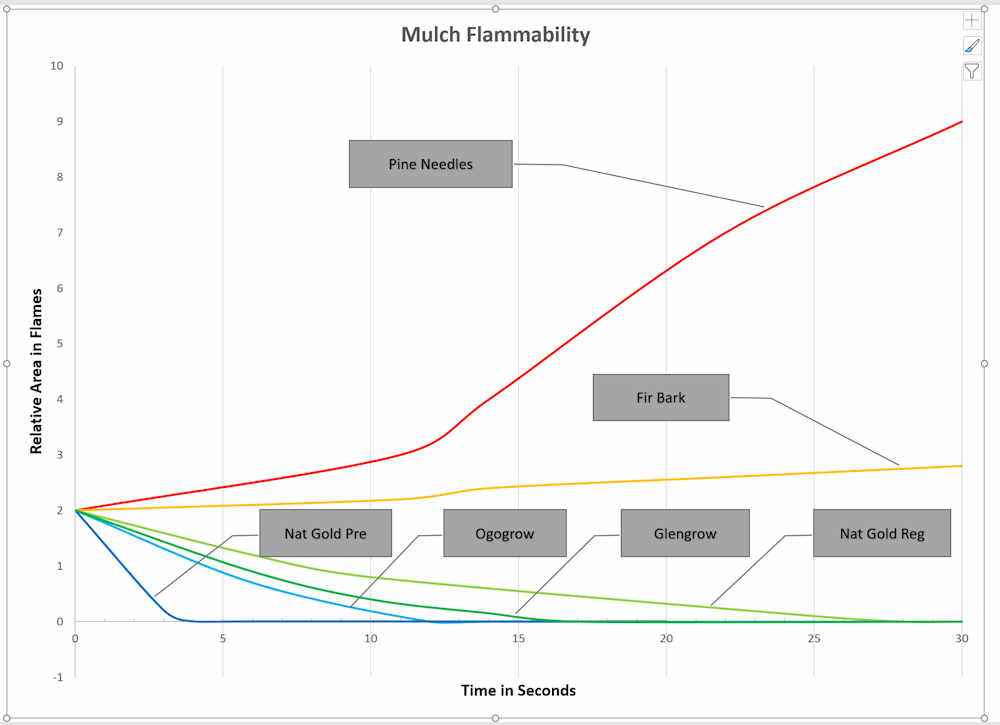
Fig. 2 – Flammability Chart
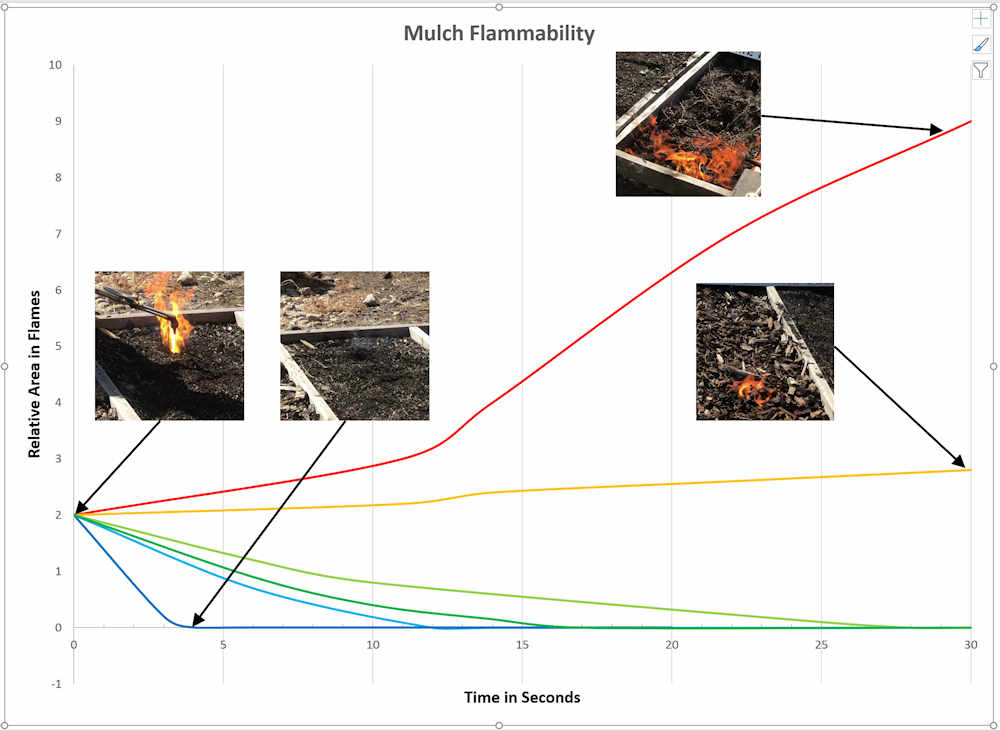
Fig. 3 – Flammability Chart with photos
The pattern you see in these charts repeated itself relatively faithfully in all our tests. Natures Gold Premium is the least flammable followed by Ogogrow, Glengrow, Natures Gold Regular, Fir Bark, and finally Pine Needles which are the most flammable.
The composted mulches (Natures Gold Premium, Ogogrow, Glengrow, Natures Gold Regular) are not very flammable. Composting appears to have a strong positive influence. The volatile elements are removed, and the particles are covered in carbon. Within the composted mulches smaller particle size makes the mulch more like organic rich soil and consequently less flammable.
Fir Bark mulch supports combustion and, while it spread very slowly on our tests, all that you need is a good wind to result in a rapid spread. We were able to confirm this with a blower (Fig.4).
Not surprisingly, pine needles and cones are very flammable even without wind. Although only a few people use pine needle debris deliberately as mulch, it is often lying on the ground in many wilder landscapes. You can probably expect the same sort of problem from any other coniferous debris such as old cedar leaves.

Fig. 4 – Flames spread in bark mulch with wind
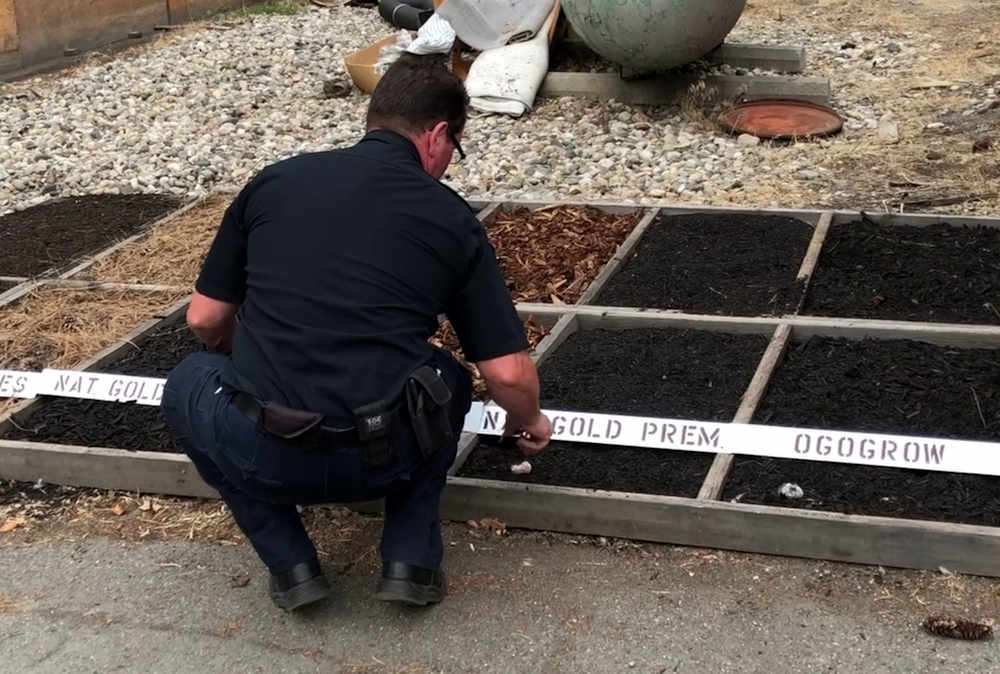
Fig. 5 – Charcoal briquets placed on mulch
The actual dates of the mulch burn tests were August 31, 2018 and August 05, 2020. Conditions for the first burn were 25 deg C, 30% humidity and for the second burn 34 deg C, and 18% humidity. The wind was relatively light for both burns. The mulch felt slightly moist to the touch digging down two inches below the surface for the first burn and did not feel moist at all for the second.
On both dates we started by placing white hot charcoal briquets on each of the mulch types to simulate their response to a hot ember falling to the ground (Fig 5). In the case of the pine needles the briquet caused them to smoke heavily and eventually they caught fire (in the 2018 burn). The bark smoked moderately but never ignited, and the other mulches only produced a small amount of smoke.
The second flammability test consisted of exposing the mulch to open flame in the form of a torch. All the mulches caught fire quickly with the torch, especially in 2020 when an acetylene torch was used (Fig. 6). On both dates the fire started by the torch in the pine needles spread relatively quickly. The flames in the bark died down slowly in the 2018 test, but in the 2020 test they stayed lit and spread very slowly. The flames in the composted mulches all died down quickly to where they were only smoking slightly (Fig. 7).
In the 2020 test we tried using a leaf blower to simulate wind. As you might expect this had a dramatic effect on the spread of flames in both the pine needles and the fir bark.
Since we saw slightly more smoke and flames for almost all the 2020 tests relative to the 2018 tests it is tempting to claim that weathered mulch is slightly more flammable than fresh mulch. However, the conditions in 2020 were hotter and drier so that must be part of the answer.
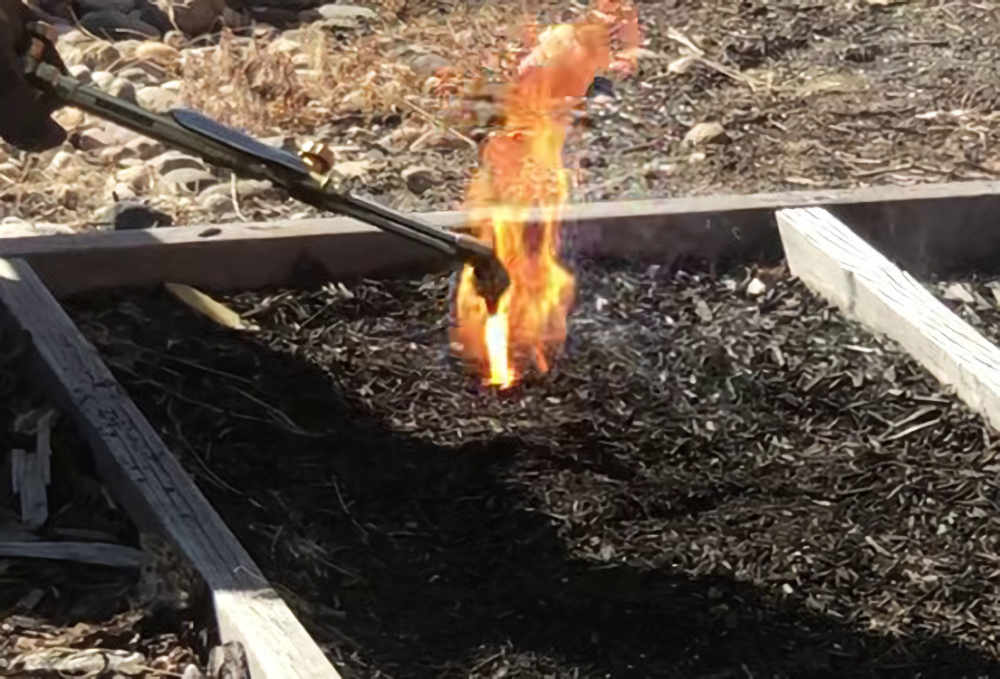
Fig. 6 – Igniting the mulch with an acetylene torch
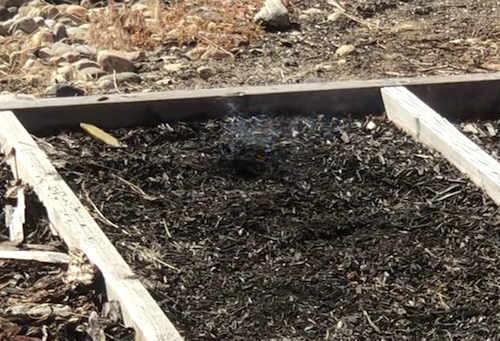

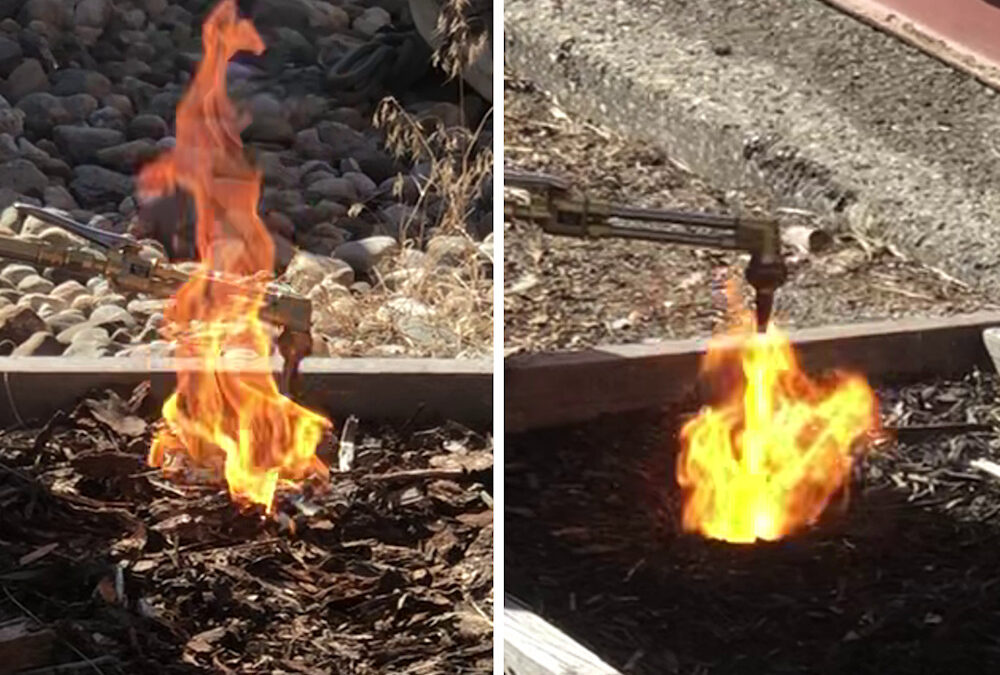

Excellent demonstration and very valuable information!
Vinyl siding melts in the presence of flame but will not support combustion until it reaches approximately 700-750 degrees. Wood ignites at 500 degrees.
If temperature in the vicinity of the mulches raises to 500 to 750 degrees, then does the mulch support combustion?
Is it not just as flammable/ more flammable than vinyl siding?
Our study did not cover building materials. That is a huge separate question. We were looking at the relative flammability of common organic mulches. All organic mulches will be flammable at some temperature and perhaps that temperature is usually lower than for vinyl siding. I do not know. All we can say is that the risk of fire transmission for composted organic mulch is clearly lower than the other mulches we tested